On 21 February 1916, Ricketts wrote in his diary:
With the Boer war, possibly the Oscar Wilde case, and probably with the advent of King Edward, whose hostility to all intellectual things and all superiorities is known and admitted, England has slipped back, perhaps for fifty years or so. The state of Art is, what it is; I will not say it could not be worse, because the powers for evil are limitless. You can always kill; to create is a separate and more complex act. A fool with a hatchet can destroy a masterpiece, and a generation may live and strive and not produce one.
After the World War, modernism appeared from the ruins, luckily.
 |
| Edward VII (National Portrait Gallery) |







